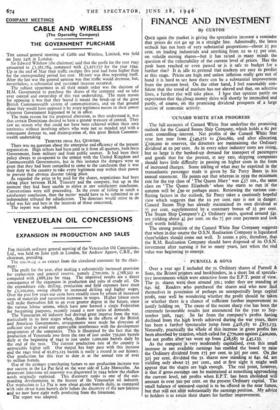FINANCE AND INVESTMENT
By CUSTOS- QNC:E again the market is giving the speculative investor a reminder that prices do not go up in a straight line. Admittedly, the latest setback has. not been of very substantial proportions—about _21 per cent. on leading industrials and anything from to to 15 per cent. on volatile mining shares—but it has raised in many minds the question of the.vulnerability of the current level of .prices. Has the . peak been reached or even passed or is it safe to budget for a further rise? It is. idle to_pretend that markets are easy to predict at this stage. Prices.are high and unless inflation really gets-out of hand it is hard to. see how there can be. a substantial improvement from the present level. On the other hand,. I feel reasonably con- fident that the trend of markets has not altered and that, on selective lines, a further rise will take place. I bgse that opinion partly on expectation that the.cheap, money drive win shortly be intensified and partly,. of course, on the promising dividend prospects of a large section' of economic activity.
'CUNARD WHITE STAR PROGRESS
The full accounts of Cunard White Star underline the promising outlook for the Cunard Steam Ship Company, which holds a 62 per cent. controlling interest. - Net profits of the Cunard White Star rose last year from . £549,272 to £600,66o, and after allocating Lroo,000 to reserves, the directors are maintaining the Ordinary dividend at to per cent. As in every other industry- costs are rising, but so large is the banked-up demand for transport of passengers and goods that for the present, at any rate, shipping companies should have, little difficulty in passing on higher costs in the form of increased charges. Some inkling of what may be expeCted in the transatlantic passenger trade is given by Sir Percy Bates in his annual statement He points out that whereas in 1939 the minimum rate for the top class of ' The Queen Mary' was £57 los., the same class on ' The Queen Elizabeth' when she starts to run in" the autumn will be L90 or perhaps more. Reviewing the various-con- flicting factors in the outlook, Sir Percy takes a cautiously hopeful view which suggests that the io per cent. rate is not in danger. Cunard Steam Ship has already maintained its own dividend at _71 per Cent. supplemented by a centenary bonus of zi per cent. The Steam Ship Qompany's Li Ordinary units, quoted around S4' s. are yielding about '41 per cent. on the 71- per cent payment and look well worth holding.
The strong positiop of the Cunard White Star Company suggests that when in due course the O.S.N. Realisation Company is liquidated shareholders should come out well. It seems a pity, therefore, that the R.M. Realisation Company should have disposed, of its O.S.I. investment after nursing it for so many years, just when the real value was beginning to emerge.
PURNELL & SONS
Over a year ago I included the 5s. Ordinary shares of Purnell & Sons, the Bristol printers and bookbinders, in a short list of specula- tive investments whic.h were attractive from the E.P.T. point of view. The 5s. shares were then around 30s.; today they are standing at 64s. 6d. Readers who purchased the shares and who now find themselves in possession of perhaps an unexpectedly large capital profit, may well be wondering whether the profit should be taken or whether there is a chance of sufficient further improvement to justify holding on. The cause of the recent sharp rise has been the extremely favourable results just announced for the year to Sep- tember 30th, 1945: So far from the company's profits having declined from the high levels achieved during the war years, there has been a furthet -spectacular jump from £428,585 to L815,133. Naturally, practically the whole of this increase in gross profits has been absorbed by taxation, which called for L77o,000 against Loom°, but net profits after..tax were up from £28,585 to L45,133.
As the company is very moderately capitalised, even this small increase in net available earnings has enabled the board to raise the Ordinary dividend from 17f per cent, to 32k per cent. On She 32+ per cent. dividend the 5s. shares now standing at 64s. 6d. are yielding only about 2+ per cent., and at first sight it might well appear that the shares are high enough. The real point, hoWever, is that if gross earnings can be maintained at something approaching the current level, net profits when E.P.T. has been abolished will amount to over 300 per cent. on the present Ordinary capital. The small balance of unissued capital is to be. offered in the near future, • but that will not alter substantially the earnings position., My advice to holders is to retain their shares for further improvement.






























 Previous page
Previous page